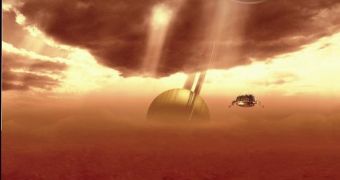What originally sounded like a crazy proposition is now beginning to make more and more sense as each day passes. Experts at the American space agency, NASA, are currently drawing up plans for a future mission on Titan, Saturn's largest moon, which will use a boat, rather than a lander, for the first time. The agency has never tried out anything like this in all its years of space exploration, but data sent back by the Cassini spacecraft, currently in orbit around the gas giant, seems to suggest that there is no reason why this idea should be ignored, PhysOrg reports.
Images and other readings sent back by the NASA/ESA space probe have revealed without a doubt the existence of lakes at Titan's north pole, and planetary scientists and geologists believe that they may be filled with liquid hydrocarbons, such as methane and ethane. Under such circumstances, creating a boat of sorts to navigate the lakes could be a little easier than building a fixed lander, some believe. The science team that came up with the new proposals is led by Washington, DC-based Proxemy Research expert Dr. Ellen Stofan. She has studied the idea for about two years, and now believes that enough data is gathered to submit a final proposition to NASA.
The two lakes that her team proposes are Ligeia Mare and Kraken Mare. The latter is larger than the Caspian Sea, which is considered among scientists to be the largest in the world today. Analysts say that, if the mission is accepted and succeeds, then it would represent the first time an extraterrestrial body of liquids is explored. However, there are still numerous obstacles to consider, the largest one of them being the fact that Titan's surface temperature is on average around minus 179 degrees Celsius. Still, this obstacle could be exceeded fairly soon. Stofan says that the Titan Mare Explorer (TiME) mission may be launched as soon as January 2016, if the will to do so exists.
Among the proposed instruments for the new mission are cameras, thermometers, meteorology instruments, sonars and mass spectrometers, among other things. These features would give the boat the ability to conduct a full range of scientific investigations of the Saturnine moon precisely from its most important spots, the hydrocarbon lakes. Bids for the NASA Discovery Class program, which opens in 2010 and may represent the best chance the lander has of coming to life, open in 2010.

 14 DAY TRIAL //
14 DAY TRIAL //